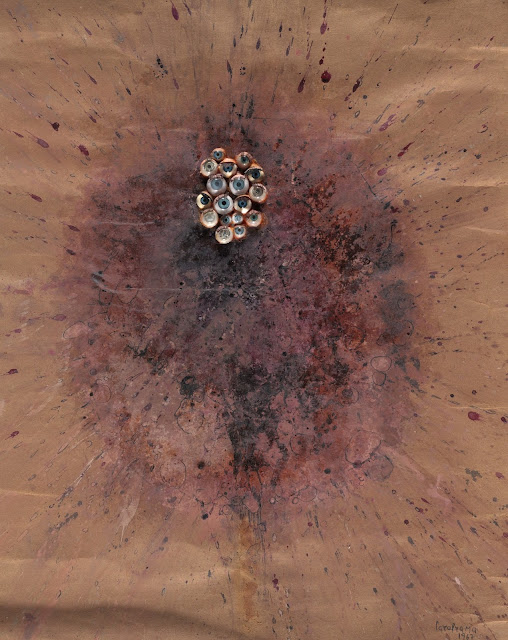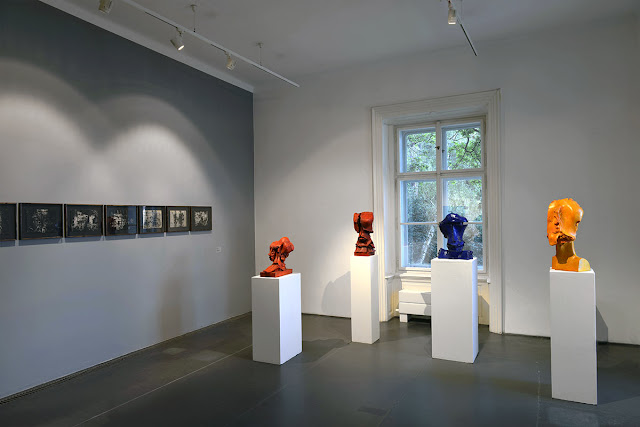
Painting is like silent poem, said Simonides, poet from ancient Greece.Paintings are icons, doors to the Platonian world above the heavens. Paintings on my blog are just those icons, which lead a viewer into the magic world of harmony and beauty. Artists who present their achievements on my blog have a very different cultural and national background, they represent variety of artistic traditions and schools
Carol Rama
"Olga Carolina Rama, called Carol Rama, was born in Turin in the 1918. He started painting again as a teenager without having any academic training, but stimulated by the attendance of important protagonists of the Turin, Italian and international cultural milieu, including Felice Casorati, Edoardo Sanguineti, Massimo Mila, Albino Galvano, Carlo Mollino, Paolo Fossati, Carlo Monzino , Luciano Berio, Eugenio Montale, Andy Warhol, Man Ray.
Following painful family incidents, including the mother's psychiatric treatment and the probable suicide of his father, his art becomes a way to exorcise suffering and inner fears.
It initially came to the visionary nature of surrealism, then to Dubuffet and art brut, and later to join the abstract research of the MAC-Movimento d'Arte Concreta in the early Fifties and the poetics of the object trouvé in the 1960s and 1970s, until cycles of more recent works (his last work dates back to 2007) develops a completely personal and autonomous path, adopting different materials, themes and styles capable of giving voice to his dream universe characterized by a provocative iconography, suspended between transgression, eccentricity, autobiography and explicit eroticism."(www.rossorubino.tv)
Following painful family incidents, including the mother's psychiatric treatment and the probable suicide of his father, his art becomes a way to exorcise suffering and inner fears.
It initially came to the visionary nature of surrealism, then to Dubuffet and art brut, and later to join the abstract research of the MAC-Movimento d'Arte Concreta in the early Fifties and the poetics of the object trouvé in the 1960s and 1970s, until cycles of more recent works (his last work dates back to 2007) develops a completely personal and autonomous path, adopting different materials, themes and styles capable of giving voice to his dream universe characterized by a provocative iconography, suspended between transgression, eccentricity, autobiography and explicit eroticism."(www.rossorubino.tv)
Manoucher Yektai - Abstract Expressionism
Manoucher Yektai (born December 22, 1921) is an Iranian American artist who belongs to the school of New York School Abstract Expressionist.
"Manoucher Yektai’s life has brought him through three cultures: Iran, France, the United States. This trajectory can be seen as a search for Modernism, and for a participation in Modernism, indeed, for a home in it. For a painter, the itinerary seems clear in its meaning: from Iran where, under Islamic strictures about imagery, free artistic expression was not available, first (with a brief pause in New York) to the ripe ambience of the School of Paris, then (more permanently) to the fledgling excitement of the emerging New York School.
But Yektai's development, seen in a larger frame, has not been entirely simple and linear. His trajectory through three cultures seems nomadic, and his identification with Modern New York seems an acceptance of hybridity in the post-Modernist sense; but at the same time, in a kind of artistic double life, he has been careful to maintain his rootedness directly in Persian culture. While he paints in a Modern Western style and is known as an embodiment of the idea of absolute freedom of expression as in Action Painting, still, with another part of his mind, or his heritage, he writes, in the Persian language, long poems which, while they share a sense of mysticism with Rumi, are modern free verse. .....In his insistence on at least residual figuration in even his most abstract works, Yektai retained awareness of what deKooning referred to when he said, about the origin of abstraction: "One day some painter used 'Abstraction' as a title for one of his paintings. It was a still life. And it was a very tricky title."6 For Yektai also it was obvious that gestural abstraction was rising out of the still life in a lineage that went back to Cezanne, and he did not wish to disguise this fact in his work. Yet in his paint-handling and his feelings toward painting as a medium he definitely shared a lot with the mainstream Abstract-Expressionists. Ashbery remarked that Yektai's work was "only superficially similar" to Abstract Expressionism,7 but the question whether paint handling is really a superficial issue in this art historical context remains open. "I must be some kind of Action Painter," Yektai acknowledges, in addressing the question. He has always felt a change of state, into something like the absorption of sex, while engrossed in painting, and all through his student years he had painted instinctively and with the canvas flat on the floor long before he had heard of Pollock's practice. "(yektai.com)
"Manoucher Yektai’s life has brought him through three cultures: Iran, France, the United States. This trajectory can be seen as a search for Modernism, and for a participation in Modernism, indeed, for a home in it. For a painter, the itinerary seems clear in its meaning: from Iran where, under Islamic strictures about imagery, free artistic expression was not available, first (with a brief pause in New York) to the ripe ambience of the School of Paris, then (more permanently) to the fledgling excitement of the emerging New York School.
But Yektai's development, seen in a larger frame, has not been entirely simple and linear. His trajectory through three cultures seems nomadic, and his identification with Modern New York seems an acceptance of hybridity in the post-Modernist sense; but at the same time, in a kind of artistic double life, he has been careful to maintain his rootedness directly in Persian culture. While he paints in a Modern Western style and is known as an embodiment of the idea of absolute freedom of expression as in Action Painting, still, with another part of his mind, or his heritage, he writes, in the Persian language, long poems which, while they share a sense of mysticism with Rumi, are modern free verse. .....In his insistence on at least residual figuration in even his most abstract works, Yektai retained awareness of what deKooning referred to when he said, about the origin of abstraction: "One day some painter used 'Abstraction' as a title for one of his paintings. It was a still life. And it was a very tricky title."6 For Yektai also it was obvious that gestural abstraction was rising out of the still life in a lineage that went back to Cezanne, and he did not wish to disguise this fact in his work. Yet in his paint-handling and his feelings toward painting as a medium he definitely shared a lot with the mainstream Abstract-Expressionists. Ashbery remarked that Yektai's work was "only superficially similar" to Abstract Expressionism,7 but the question whether paint handling is really a superficial issue in this art historical context remains open. "I must be some kind of Action Painter," Yektai acknowledges, in addressing the question. He has always felt a change of state, into something like the absorption of sex, while engrossed in painting, and all through his student years he had painted instinctively and with the canvas flat on the floor long before he had heard of Pollock's practice. "(yektai.com)
Jan Koblasa - Czech sculptor, artist and poet
Jan KOBLASA (1932-2017) Czech poet, graphic, painter, scenographer, sculptor, writer, university educator and artist .
"Jan Koblasa was born on October 5th 1932 in Tabor. Koblasa is one of the leading figures in European sculpture second the 20th century. His expressive symbolic, avant-garde work is oriented development studies at the Prague Academy of Fine Arts (1952-1958). With several young protesters then initiates establishment of the "Klub" (from 1957 group Spidrové), reacting to recessions neodadaistickou zmrtvělost and absurdity of the time. Impressed concrete music, expressionism, and existential philosophy tries to even the statues paintings express my sense of life. Becomes the leader of the younger generation and one of the prominent nekonformního, radically oriented art. Attend the first informal, then Czechoslovak prestigious exhibitions of modern art at home and abroad. The occupation of Czechoslovakia in August 1968, it captures in Italy. Coming back. Gaining asylum in northern Germany. In 1969, based in Kiel at the Fachhochschule Study Muthesius free sculpture, which the professor leading up to 1998. He lives in Hamburg, where his work is well received and respected. The specific form of expressive, content-rich expression, which first went through phases of radical abstraction, holds unconventional views of man and his destiny. Contributes to the emphasis on a mythical archetype of cinematography, in which the message is Koblasa analogy to the current life experience. Until now prepared - mostly in Europe - about a hundred solo exhibitions. In his work has won numerous awards and his works own the world's major collections. Representative of the artist's monograph published in Czech and German."(galerieubetlemskekaple.cz)
Subscribe to:
Posts (Atom)



















































